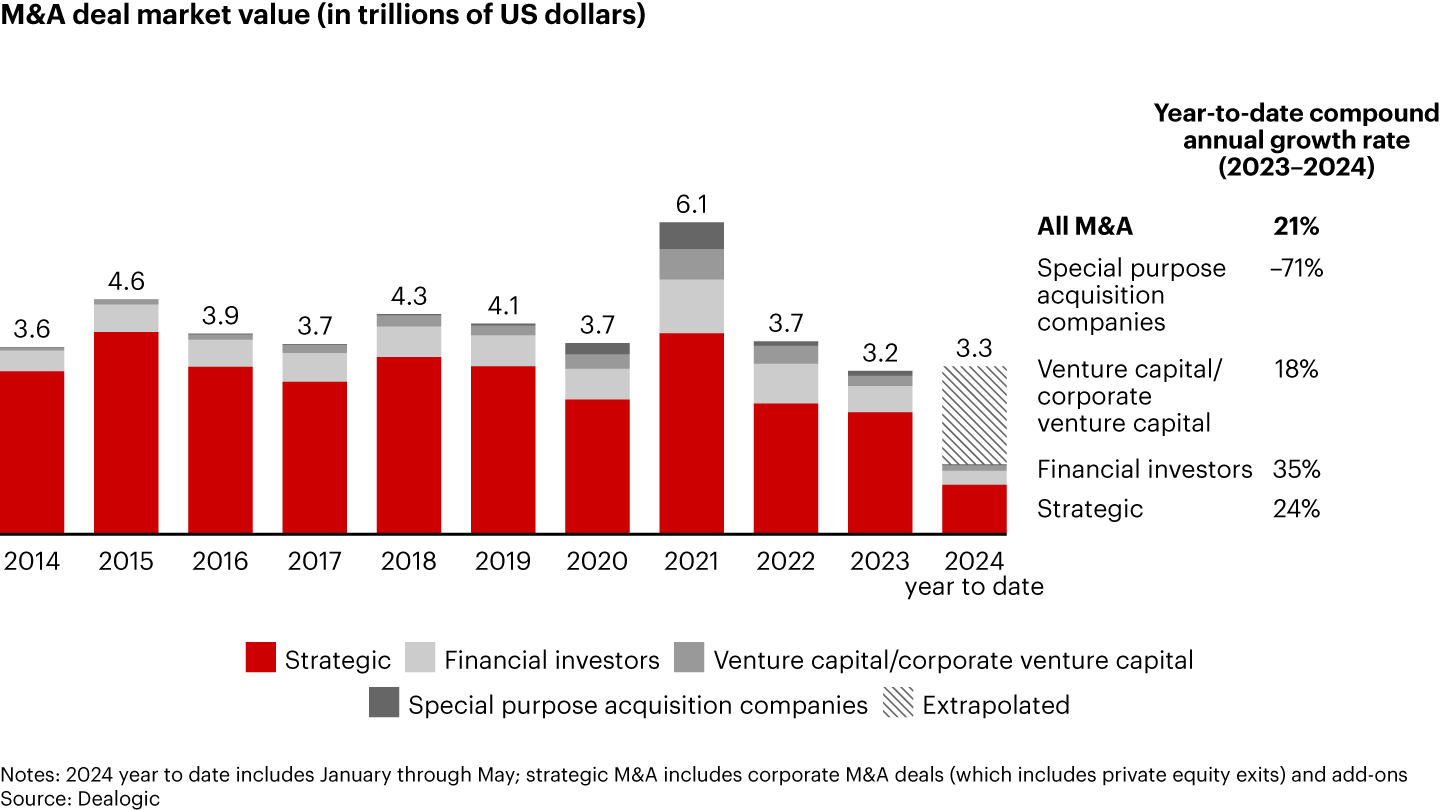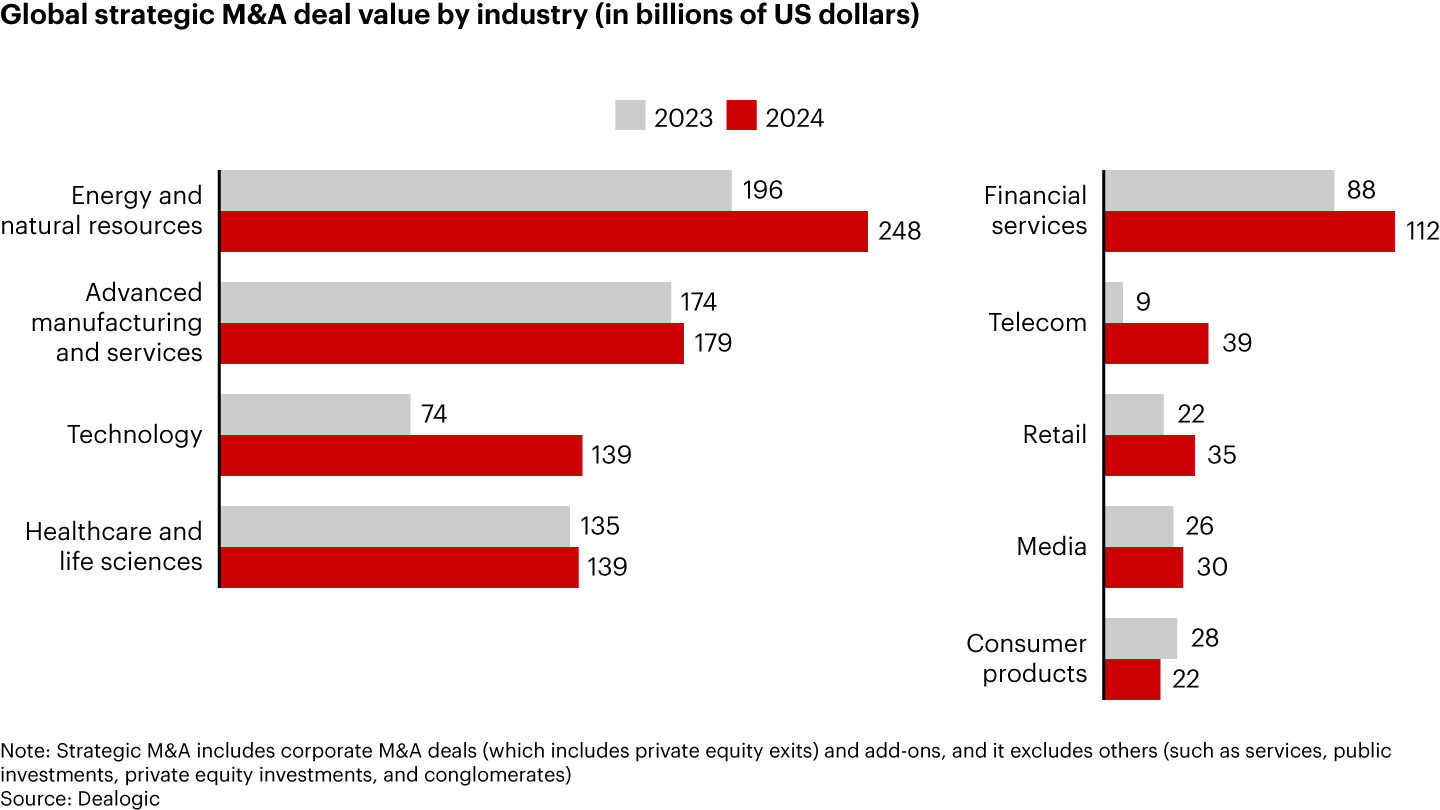Report
 }
}
At a Glance
- Companies are getting adept at adapting dealmaking to the economic environment.
- More dealmakers are emphasizing cost synergies in scope deals.
- Strategic M&A has been steady over the past 12 months, with 2024 deal value expected to be on track to end slightly above 2023.
- The big action is in the energy sector, and the tech sector is still alive and kicking as well.
The first half of 2024 brought with it a continuation of both higher interest rates and heavy regulatory scrutiny of deals, yet companies are finding ways to adapt to these conditions, showing signs of more sophisticated approaches to value creation through M&A.
Deals maintained the steady pace in volume and value growth that began in the last half of last year. But look deeper into the 2024 data, and you find two main areas of activity. The energy sector moved the needle the most, making a big shift to scale consolidation deals from scope energy transition deals. The other big center of activity was the tech sector, in which companies continued to focus on growth-oriented scope deals, although not nearly at the rate seen in the 2020–2021 boom.
As the macro environment of higher interest rates, persistent inflation, and geopolitical risks continues to challenge companies, dealmakers are showing new flexibility in the types of deals they choose and how those deals are getting done. Indeed, if there’s one lesson from the 2024 activity, it’s that companies are making deals designed to deliver both cost synergies and growth—not one or the other.
For example, with companies facing pressure to quickly pay down debt, more scope deals are predicated on achieving scale synergies. At the same time, even scale deals are crafted on the basis of combining products, expanding into new customer or market segments, or other means of generating growth in addition to cost savings. And to avoid expensive debt financing, more companies (especially in the energy sector) are taking advantage of high public market valuations to go for all-stock deals. In fact, the proportion of value coming from stock-only deals reached a 20-year high.
Market overview and key observations
The global market for strategic M&A posted value and volume activity through the end of May 2024 at a rate that is similar to the performance we saw in the last half of 2023. Overall deal value rose by 24% against an anemic early 2023 (see Figures 1 and 2). Private equity (PE) and venture capital appear to have bottomed out and are starting to show improvement. Yet, financial sponsors have failed to hit launch speed in the face of high borrowing costs, a slow exit pace, and fundraising challenges. (For more, see Searching for Momentum: Private Equity Midyear Report 2024.) And taking a regional view, the Americas and Europe, the Middle East, and Africa are continuing to experience a return to dealmaking while Asia-Pacific is in the middle of another down year (see Figure 3).






Strategic deal valuations have moved up a bit, hinting that pricing may have seen a bottom. Our conversations with executives suggest a willingness to pay for solid businesses that reinforce strategic priorities, but skepticism persists on most assets they see. At the same time, sellers seem to be holding out, as evidenced by the unsteady return of the initial public offering market and PE’s lengthening holding periods. And public market valuations remain well above deal valuations (see Figure 4). So far, the marginal uptick in deal valuations is not enough to resolve the logjam of deals we pointed out in our Global M&A Report 2024.


Where the deals are
So what deals are happening? Let’s look at four key sectors.
Energy and natural resources. Most dramatically, big consolidation plays represented roughly 25% of deal value over the first five months of 2024 (see Figure 5). ExxonMobil’s $60 billion offer for Pioneer last October was the first volley in a rash of commodities-driven dealmaking that continued into 2024. It was followed by Chevron’s $53 billion purchase of Hess, announced the same month. Then came relatively smaller activity in early 2024: Diamondback Energy’s $26 billion bid for Endeavor, ConocoPhillips’ $23 billion acquisition of Marathon Oil, and Chesapeake Energy’s $12 billion all-in purchase of Southwestern. The fact that 90% of all energy sector deals this year have been primarily in the traditional oil and gas space reflects the recognition that businesses and consumers will depend on oil and gas for many years to come, requiring energy companies to shore up their core positions.


Advanced manufacturing. Industrial companies also have been focusing more on scale M&A in 2024. More than 70% of the manufacturing sector’s deals were primarily for scale, and the deal theses for scope activity also were predicated on generating cost synergies. In a few deals, global buyers sought to strengthen their presence in the US. That was the impetus behind Japan’s Sekisui House’s purchase of MDC Holdings, a US homebuilding business, and Italy-based Prysmian’s acquisition of Encore Wire.
Again, the pursuit of bankable cost synergies was evident in many large industrial scope deals. International Paper’s offer for the UK’s DS Smith expands the core business footprint to a new geography of the more than $500 million in announced synergies, $475 million come from cost. Owens Corning’s bid for Masonite expands its building products portfolio into doors and also is expected to deliver $125 million in cost synergies.
Healthcare and life sciences. Healthcare remains a major catalyst for strategic M&A as companies seek to shore up top-line growth and optimize portfolios around therapeutic areas and technologies. Consider Novartis’s purchase of Mariana Technology to deepen its offering in radioligand therapies or Johnson & Johnson’s purchase of Shockwave Medical, its third cardiovascular deal in as many years. Carve-outs continue to be a key component of healthcare portfolio optimization. Thus far, the biggest healthcare carve-out deal of 2024 was 3M’s spin-off of Solventum, and Baxter announced plans to spin off its renal care unit in the second half of 2024 after divesting its biopharma business just last year. Spin-offs can be hard to get right, however, and sometimes a separated asset finds a new home in someone else’s portfolio instead (for more, see “Few Corporate Spinoffs Deliver Value”). That’s what happened with the sale of Edwards Lifesciences’s critical care business to Becton, Dickinson and Company (BD). With this deal, BD reinforces its increasing importance in connected patient care while Edwards renews its focus on structural heart disease.
Technology. Tech M&A is slowly and partially coming back. The sector’s deal value has nearly doubled year over year, a major factor in the overall strategic market upswing. Yet deal volumes have lagged.
Why? Buyers and sellers continue to navigate meaningful bid-ask spreads as each side digests record-high valuations from just a few years ago. As we explored in “M&A in Technology: Getting Serious about Product Synergies,” many companies have traditionally found it difficult to capture the full potential in revenue synergies. Meanwhile, growth deals are harder to pencil out as the cost of capital remains higher for longer.
The current premium for deals that pay down debt is evident in one of the biggest tech deals of early 2024. In January, Synopsys announced a $35 billion bid for Ansys. The deal seeks to transform Synopsys’s product development software with Ansys’s simulation capabilities. The acquisition expanded Synopsys’s addressable market and was aimed at delivering at least $400 million in revenue synergies. It was also intended to help the acquirer achieve rapid deleveraging and $400 million run-rate cost synergies, reflecting the need to use deals for both growth and cost savings.
The tech sector’s preoccupation with generative AI is starting to be felt in the M&A activity. Generative AI companies received at least 110 early-stage investments totaling $7.5 billion in the first quarter of 2024 alone as start-ups sought capital to build out foundational models. In those same three months, 11 deals for outright control were reported, according to Dealogic. That’s a number that will likely rise in the remaining months of 2024 as the appetite for generative AI continues to expand.
Generative AI in tech is only one of the many forces that will come into play in the months ahead as more companies across all industries look for ways to use the dynamic technology to gain an edge over competitors. Other factors include the lingering interest rate question—how high for how long? There are the ramifications of global elections, especially in the US. And could there be a shift in regulatory scrutiny?
Regardless of how these issues play out over the rest of 2024, one thing is certain. As we pointed out in our brief “How Companies Got So Good at M&A,” dealmakers are adapting their M&A processes (from screening to diligence to integration) to meet changing environments. We see that ability in the current shift to targeting cost synergies in growth deals and growth synergies in cost deals. Companies making such flexible and advanced moves and learning as they go will be those that reap the most benefits from M&A.
Note: All deal values are based on Dealogic data.